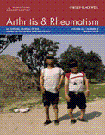Erythrocyte C3d and C4d for monitoring disease activity in systemic lupus erythematosus
Abstract
Objective
Disease activity in systemic lupus erythematosus (SLE) is typically monitored by measuring serum C3 and C4. However, these proteins have limited utility as lupus biomarkers, because they are substrates rather than products of complement activation. The aim of this study was to evaluate the utility of measuring the erythrocyte-bound complement activation products, erythrocyte-bound C3d (E-C3d) and E-C4d, compared with that of serum C3 and C4 for monitoring disease activity in patients with SLE.
Methods
The levels of E-C3d and E-C4d were measured by flow cytometry in 157 patients with SLE, 290 patients with other diseases, and 256 healthy individuals. The patients with SLE were followed up longitudinally. Disease activity was measured at each visit, using the validated Systemic Lupus Activity Measure (SLAM) and the Safety of Estrogens in Lupus Erythematosus: National Assessment (SELENA) version of the Systemic Lupus Erythematosus Disease Activity Index (SLEDAI).
Results
At baseline, patients with SLE had higher median levels of E-C3d and E-C4d (P < 0.0001) in addition to higher within-patient and between-patient variability in both E-C3d and E-C4d when compared with the 2 non-SLE groups. In a longitudinal analysis of patients with SLE, E-C3d, E-C4d, serum C3, and anti–double-stranded DNA (anti-dsDNA) antibodies were each significantly associated with the SLAM and SELENA–SLEDAI. In a multivariable analysis, E-C4d remained significantly associated with these SLE activity measures after adjusting for serum C3, C4, and anti-dsDNA antibodies; however, E-C3d was associated with the SLAM but not with the SELENA–SLEDAI.
Conclusion
Determining the levels of the erythrocyte-bound complement activation products, especially E-C4d, is an informative measure of SLE disease activity as compared with assessing serum C4 levels and should be considered for monitoring disease activity in patients with SLE.




